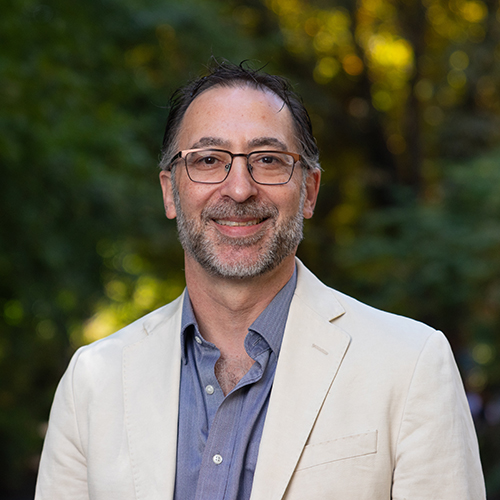Evolutionary biologists are not necessarily accustomed to publicity, but Carl Bergstrom is getting used to it. In the past few months, his research findings have been both hailed and criticized in the media, with coverage on National Public Radio and in publications ranging from Science to The New York Times.

The focus of the controversy? Avian influenza, also known as bird flu.
Bergstrom, associate professor of biology, is an evolutionary biologist with an interest in microbial systems. “If you’re an evolutionist, microbes are wonderful organisms to study,” says Bergstrom. “They have a short generation time, enormous population sizes, and they evolve super fast in really harsh environments—in the presence of antibiotics, for example. You can watch evolution happen not just in your lifetime, but in one week.”
In the past, Bergstrom has studied how this rapid evolution has led to antibiotic resistant strains of bacteria in hospitals, and he has analyzed possible approaches to minimizing the development of resistant strains. More recently he has turned his attention to bird flu.
Bird flu is caused by a virus that naturally occurs in birds. Most carry the virus without becoming ill, but for some domesticated birds, such as chickens and turkeys, the virus can be fatal. Its spread to humans has been rare, with most cases involving direct contact with diseased poultry or their secretions. The concern is that the virus may evolve into a form that spreads more easily between humans, sparking a deadly influenza epidemic.
With his interest in evolution and health care, Bergstrom has been drawn to the study of avian influenza. Human-to-human infection with the virus has already been reported in a small number of cases, he says, increasing concern worldwide. The World Health Organization (WHO) has announced plans to use antiviral drugs prophylactically in large populations where the flu starts to emerge — sometimes referred to as the “fire-blanket approach” — to prevent the disease from taking off.
“Other scientists have done computer simulations that show that if we act quickly enough, with a large enough population, and get a bit lucky about the speed of spread, we might be able to control the disease,” says Bergstrom.
Working with colleagues at Harvard University School of Public Health, Bergstrom used what he describes as a “very straightforward” mathematical model to ask a simple question: If the bird flu appears once, what are the chances that it will break out again in the near future—from one week to several years from the initial appearance?
The assumption has been that the odds are low, since past human pandemics have emerged only about every 30 years. But in the past, pandemics simply ran their course. This would be the first to be controlled with a massive prophylactic effort.
Bergstrom’s team concluded that the risk of a secondary outbreak is high, due to the potential for a cluster of introductions of the flu. The blanket treatment might contain one strain in one region, but that would not preclude the introduction of another strain elsewhere.
“In the past, we never knew a pandemic was happening until it was too late,” he says, “and there wasn’t the monitoring to confirm whether those pandemics involved just one strain or multiple strains of a virus. Our argument is that even if we contain bird flu, we should plan for reintroduction fairly shortly. We’re advocating a cautious approach.”
Bergstrom says his findings clearly supported the WHO’s containment strategy, with the caveat that we can’t assume that containment will be followed by 10 or 30 years of respite. But some people were angered by the findings, believing that they undermined the proposed containment strategies.
“I was very surprised by the controversy the paper ignited,” says Bergstrom.
“I thought our findings were embarrassingly obvious, not controversial.” After receiving criticism, Bergstrom and his colleagues carefully reviewed their study to see if they had made an error.
“What we saw is that the source of the controversy was a difference in starting assumptions,” says Bergstrom. The team started with the assumption that most disease introductions are clustered rather than a single event; they based this on what is known about viruses like HIV and SARS, since no data exists for past flu pandemics. He stands by his assumptions and his results.
In the end, says Bergstrom, the controversy and the need to be thick-skinned are not a big deal. But being correct is. “As scientists, we’re trained to be a bit like debaters. You lay out your argument and try to be compelling. Here we can’t afford to be compelling. We need to be right. The stakes are very high. We believe we’re on to something important here and we want to change policy in a positive way.”
As more cases of bird flu emerge, Bergstrom and other scientists will have more data to work with, making prediction a bit easier. Even with Bergstrom’s worst-case scenario — an outbreak that is controlled but followed by a secondary outbreak three months later — there is a silver lining. “Those three months between outbreaks could be very useful to understanding the disease,” he says.
That said, Bergstrom wants people to know that the probability of a bird flu pandemic remains relatively low. “It’s just that it is within the realm of possibility,” he says, “so we need to take serious precautions. I think it’s a mistake to plan for the best-case scenario rather than the worst-case scenario.”
More Stories

The Public Impact of Private Cities
Geography major Edwin Bai has researched private cities, developed by individuals and corporations, that "take the libertarian idea of low government regulation to the maximum."

The Curious Journey of Chinese Characters
Several Asian countries adapted the Chinese writing system—the oldest writing system still in use—for their own languages. In a new book, Professor Zev Handel shares how that happened.

Can Machines Learn Morality?
UW researchers at the Institute for Learning & Brain Sciences and in the Allen School are exploring the potential for training AI to value altruism.